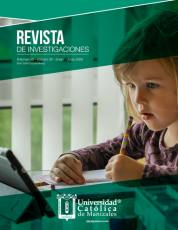Measurement of school climate in public educational institutions in Cali, Colombia.
DOI:
https://doi.org/10.22383/ri.v22i39.187Keywords:
citizenship education, student wellness, schools, scholar climate, Cali, ColombiaAbstract
The objective of this article is to measure school climate to provide public educational institutions with a concrete, evidence-based and quantitative analysis of the situation. At the methodological level, a descriptive cross-sectional study with a quantitative approach is used. The variables addressed in this study were grouped into three modules: school climate test, individual student well-being and family functionality, as well as a survey of factors associated with school climate. The study was carried out in 51 institutions, with a population of 38,047 students enrolled in grades 6 to 11. According to the findings, it can be concluded that the school climate is influenced by internal and external dynamics. Dysfunctional families, lack of support and guidance affect student relationships, risk and threat factors such as theft, consumption and trafficking of psychotropic substances, presence of weapons, gangs and alcohol consumption, affect student relationships, leading to violence and insecurity within the institutions.
References
Arango, C. (2005). Hacia una Psicología de la convivencia. Revista Psicogente, 8(14), 65-79. Recuperado el 10 de agosto de 2019 de: https://dialnet.unirioja.es/descarga/articulo/6113939.pdf.
Arellano, N. (2007). La violencia escolar y la prevención del conflicto. Orbis. Revista Científica Ciencias Humanas, 3(7), 23-45. Recuperado el 15 de agosto de 2019 de: https://www.redalyc.org/pdf/709/70930703.pdf.
Arias, W. (2013). Agresión y violencia en la adolescencia: La importancia de la familia. Avances en Psicología, 22(1), 23-34. Recuperado el 10 de agosto de 2019 de: http://revistas.unife.edu.pe/index.php/avancesenpsicologia/article/view/303.
Castilla H., Caycho T., Shimabukuro M., Valdivia A. (2014). Percepción del funcionamiento familiar: Análisis psicométrico de la Escala APGAR-familiar en adolescentes de Lima. Propósitos y Representaciones, 2(1), 49-78. http://dx.doi.org/10.20511/pyr2014.v2n1.53.
Chirkina, T., & Khaveonson, T. (2018). School Climate: A History of the Concept and Approaches to Defining and Measuring it on PISA Questionnaires. Russian Education & Society, 60(2), 133–160. DOI: https://doi.org/10.1080/10609393.2018.1451189.
Claro, T. J. (2013). Calidad en educación y clima escolar: apuntes generales. Estudios Pedagógicos, 39(1), 347-359. Recuperado el 10 de agosto de 2019 de: https://scielo.conicyt.cl/pdf/estped/v39n1/art20.pdf.
García, S. M. (2009). Clima Organizacional y su Diagnóstico: Una aproximación Conceptual. Cuadernos de Administración, (42), 43-61.
Giménez, C. (2009). El impulso de la convivencia ciudadana e intercultural en los barrios europeos: marco conceptual y metodológico. Barcelona. Recuperado el 3 de agosto de 2019 de: https://www.diba.cat/c/document_library/get_file?uuid=119bebdf-85f4-4403-97ed-6fb79527a4da&groupId=1295730.
Gorrochotegui Martell, A., Vicente Mendoza, I., & Torres Escobar, G. (2014). Evaluación de un proceso de coaching en directivos y su impacto en el clima escolar. Educ., 17(1), 111-131. Recuperado el 10 de agosto de 2019 de: https://www.redalyc.org/pdf/834/83430693006.pdf.
Gutierrez P. Y., Veloza S. C. (2017) Hacia el fortalecimiento del clima escolar en el ciclo III de la jornada mañana del colegio Atabanzha IED: una propuesta de Gestión directiva. Universidad Libre. Facultad de Ciencias de la Educación. Maestría en Educación con Énfasis en Gestión. Bogotá D.C. Recuperado el 10 de agosto de 2019 de: https://repository.unilibre.edu.co/bitstream/handle/10901/11785/1.%20Hacia%20el%20fortalecimiento%20del%20Clima%20escolar%20en%20el%20Ciclo%20II.pdf?sequence=1&isAllowed=y
Published
How to Cite
Issue
Section
License
Copyright (c) 2023 Revista de Investigaciones

This work is licensed under a Creative Commons Attribution-NonCommercial 4.0 International License.
Attribution — You must give appropriate credit, provide a link to the license, and indicate if changes were made. You may do so in any reasonable manner, but not in any way that suggests the licensor endorses you or your use.
NonCommercial — You may not use the material for commercial purposes.
This work is licensed under a Creative Commons Attribution-NonCommercial 4.0 International License.












